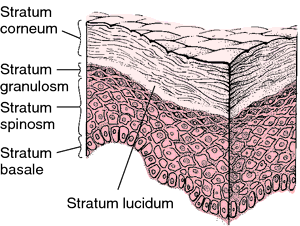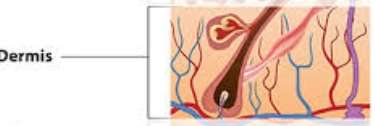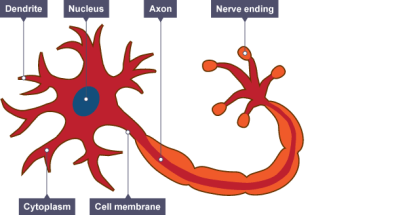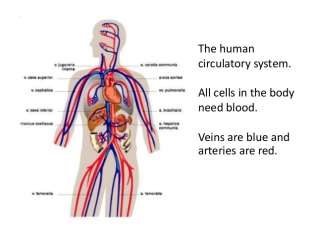The main function of the skin, its structure and the relationship between the skin, circulatory and nervous system
- Draw a label diagram of the skin and describe its structures and key parts
(See diagram attached)
The skin is the largest organ in the human body. It has three layers; the epidermis, dermis and subcutaneous layer.
The epidermis
 Google images (2016)
Google images (2016)
“The upper or outer layer of the two main layers of cells that make up the skin. The epidermis is mostly made up of flat, scale-like cells called squamous cells. These cells produce melanin, which gives the skin its colour” (MedicineNet.com 2016).
The epidermis is the outmost layer of the skin, the skin we can see. This layer differs in thickness; it is thinner on the eyelids and nipples than it is on the soles of feet and palms of hands. This layer has water resistant properties and protects us from cuts and injuries. The epidermis contains the pigment melanin which gives us our skin tone.
The dermis
 Google images (2016)
Google images (2016)
“Lying underneath the epidermis-the most superficial layer of our skin-is the dermis. The dermis is a tough layer of skin.” (Boundless.com N/D).
The dermis is the layer beneath the epidermis; this layer is attached to the blood and nerve supply. It consists of sweat glands and hair follicles and connective tissues.
The subcutaneous layer
 (Google Images 2016)
(Google Images 2016)
“The bottom layer of skin is the subcutaneous fat layer.” (American Academy of Dermatology 2016).
The subcutaneous layer is made up of fatty tissues or bundles of adipose tissue. This layer is responsible for retaining heat in the body. The smaller these bundles of adipose tissue are, the less over weight you are likely to be.
Functions of the skin
- Protection: The skin helps to protect us from things such as dehydration, harmful microorganisms, bacteria and UV rays from the sun.
- Absorption: The skin can absorb substances that the body need such as oxygen and nitrogen. Some medications/ointments may be applied to and absorbed by the skin for muscle pain, for example, deep heat or oriental tiger balm.
- Sensation: Receptors in the skin allow us to touch and feel pain, heat and cold.
- Temperature Regulation: Sweating begins at around 37°C. The sweat comes to the surface of the skin and evaporates, causing the body to reduce the heat, as well as this, the hair on our arms lie down to allow the heat to escape. When we are cold the opposite happens: the hairs stand up and goose bumps form to trap any heat in the body in order to warm us up again.
- Immunity: The skin and the immune system work together to make the immune to microorganisms and bacteria.
- Movement and growth: The skin is stretchy because of its elastic properties and this allows the covering of the whole body and the movement of the individual.
- Excretion: The skin allows materials such as urea, excess water and ammonia out of the skin. By-products that aren’t wanted or needed by the skin are released through sweat glands in the form of sweat. Excretion is an important function to note about the skin (New Health Advisor 2014).
- Vitamin production: Upon exposure to ultraviolet light (the sun), the skin produces vitamin D. This is important for the growth and strengthening of bone (Curran 2016).
The relationship between the skin, circulatory system and the nervous system.
The skin
The skin is the largest organ in the body and is wide spread throughout the whole body. The skin absorbs essential nutrients and oils through the pores and this provides moisture to the skin. The skin consists of three layers: The dermis, epidermis and subcutaneous layer.
The dermis is the layer beneath the epidermis; this layer is attached to the blood and nerve supply. It consists of sweat glands and hair follicles and connective tissues.
The epidermis is the outmost layer of the skin, the skin we can see. This layer differs in thickness; it is thinner on the eyelids and nipples than it is on the soles of feet and palms of hands. This layer has water resistant properties and protects us from cuts and injuries. The epidermis contains the pigment melanin which gives us our skin tone.
The subcutaneous layer is made up of fatty tissues or bundles of adipose tissue. This layer is responsible for retaining heat in the body. The smaller these bundles of adipose tissue are, the less over weight you are likely to be.
Functions of the skin
- Protection: The skin helps to protect us from things such as dehydration, harmful microorganisms, bacteria and UV rays from the sun.
- Absorption: The skin can absorb substances that the body need such as oxygen and nitrogen. Some medications/ointments may be applied to and absorbed by the skin for muscle pain, for example, deep heat or oriental tiger balm.
- Sensation: Receptors in the skin allow us to touch and feel pain, heat and cold.
- Temperature Regulation: Sweating begins at around 37°C. The sweat comes to the surface of the skin and evaporates, causing the body to reduce the heat, as well as this, the hair on our arms lie down to allow the heat to escape. When we are cold the opposite happens: the hairs stand up and goose bumps form to trap any heat in the body in order to warm us up again.
- Immunity: The skin and the immune system work together to make the immune to microorganisms and bacteria.
- Movement and growth: The skin is stretchy because of its elastic properties and this allows the covering of the whole body and the movement of the individual.
- Excretion: The skin allows materials such as urea, excess water and ammonia out of the skin. By-products that aren’t wanted or needed by the skin are released through sweat glands in the form of sweat. Excretion is an important function to note about the skin (New Health Advisor 2014).
- Vitamin production: Upon exposure to ultraviolet light (the sun), the skin produces vitamin D. This is important for the growth and strengthening of bone (Curran 2016).
The nervous system
The nervous system consists of the brain, spinal cord and all of the nerves that connect to these organs to the rest of the body. The cells in the nervous system are known as neurons and they transmit impulses along the nerves to carry messages between the brain and the body via the spinal cord. When the brain receives the information, it processes it before sending out the demands for the body. Neurons contain a long axon which is protects by myelin sheath as well as tiny branches called dendrons which branch out into smaller parts called dendrites ( BBC 2017).
 (BBC 2017).
(BBC 2017).
The autonomic nervous system regulates some body processes like blood pressure and breathing which work without any effort from the person. The somatic system consists of the nerves that are connected to the receptors in the skin. This is the system that protects us form getting burnt when holding or hand on a hot surface because the brain sends signals via the spinal cord to tell us to lift the hand off the surface.
Get Help With Your Essay
If you need assistance with writing your essay, our professional essay writing service is here to help!
The circulatory system
The circulatory system consists of the heart, blood containing oxygen and carbon dioxide and the blood vessels including veins, arteries and capillaries. These blood vessels have muscles inside their walls in which the blood flows through and these muscles are controlled by the nervous system. The circulatory system is responsible for providing blood, hormones, nutrients and oxygen to all the cells in the body. This system also fights infection through white blood cells and antibodies and aid in the clotting of blood through platelets which form scabs on the surface of the skin when cut and exposed to oxygen.
 (Google Images 2017)
(Google Images 2017)
The relationship between the skin, nervous system and circulatory system
The skin, nervous system and circulatory system work together in order to ensure the body is functioning the way it should. The somatic nervous system works with the central nervous system to protect the skin. It does this by telling us to lift our hand off a hot surface to avoid burning ourselves. The nervous system and circulatory system are connected by the lymphatic system and work together to maintain blood pressure and regulation of the heart. The nervous system “tells” the circulatory system to pump blood around the body. The nervous system and circulatory system needs to function correctly and work together to ensure the rest of the body is functioning properly. The nervous system controls all functions of the body. The circulatory system provides blood flow and regulates body temperature. The skin works together with it to regulate the body temperature. When too hot the blood vessels dilate, the hairs lie down and we sweat to allow excess heat to escape the body. When we are too cold the hairs stand up and goose bumps form to trap any heat in the body. If blood flow is restricted, the skin becomes pale. If one of these systems became damaged in any way, the body would have abnormal functioning (Curran 2017).
(iii) Using the table format give examples of viral, bacterial, fungal skin diseases.
|
Viral |
Bacterial |
Fungal |
|
Gastroenteritis |
Pneumonia |
Athletes foot |
|
Common cold |
Meningitis |
Cutaneous Candidiasis |
|
Flu |
Food Poisoning |
Tinea Versicolor |
|
Cold sores |
Impetigo |
Onychomycosis |
|
Chicken Pox |
Cellulitis |
Tinea Capitis |
|
Herpes |
Boils |
Ringworm |
(Native Remedies 2016)
(On Health 2016)
(Remedies health communities 2016)
Cite This Work
To export a reference to this article please select a referencing style below:


